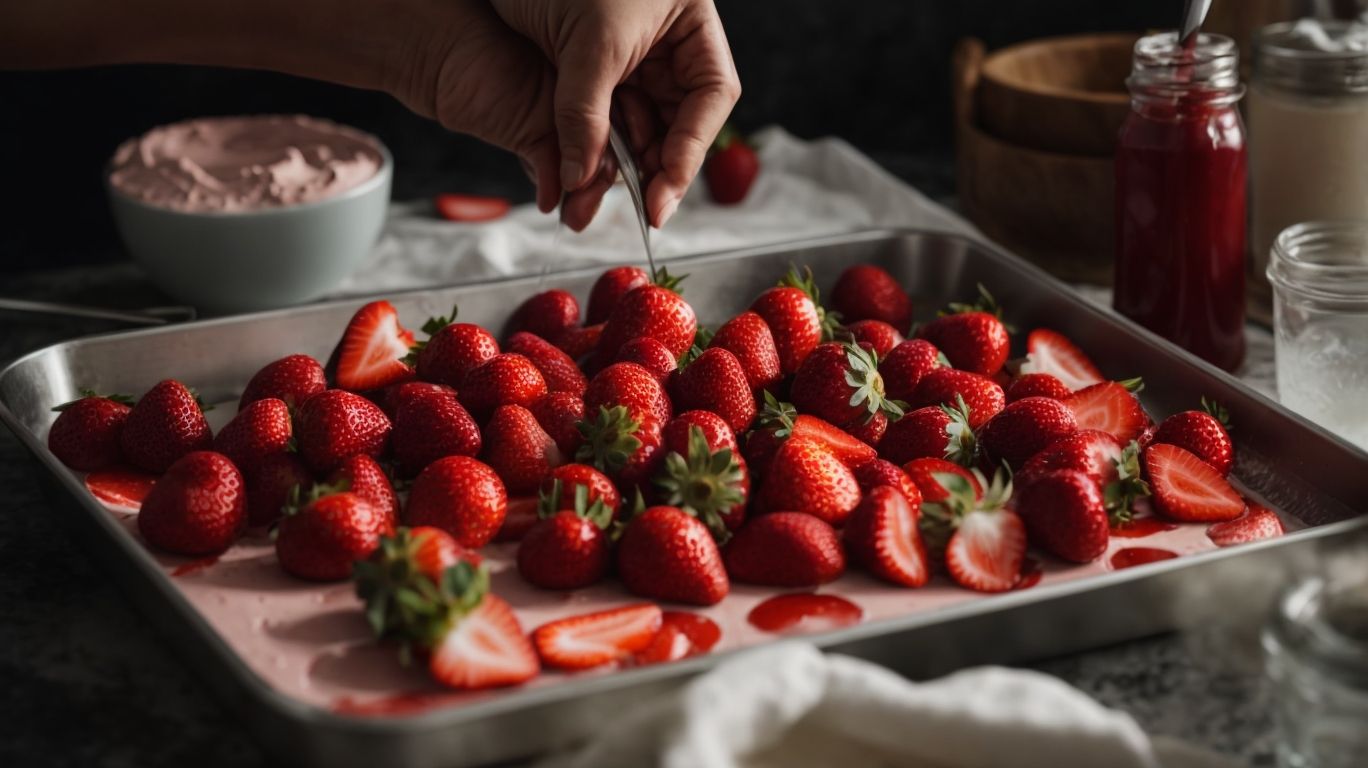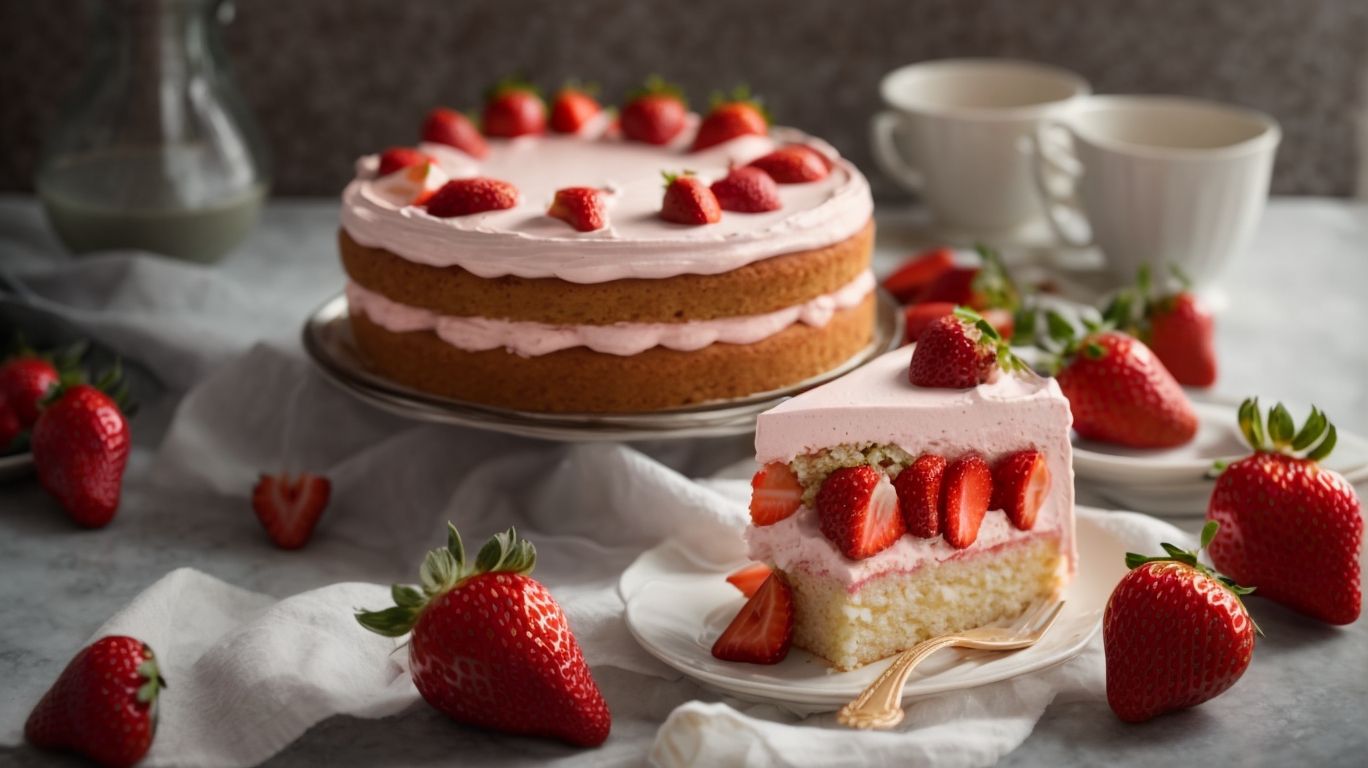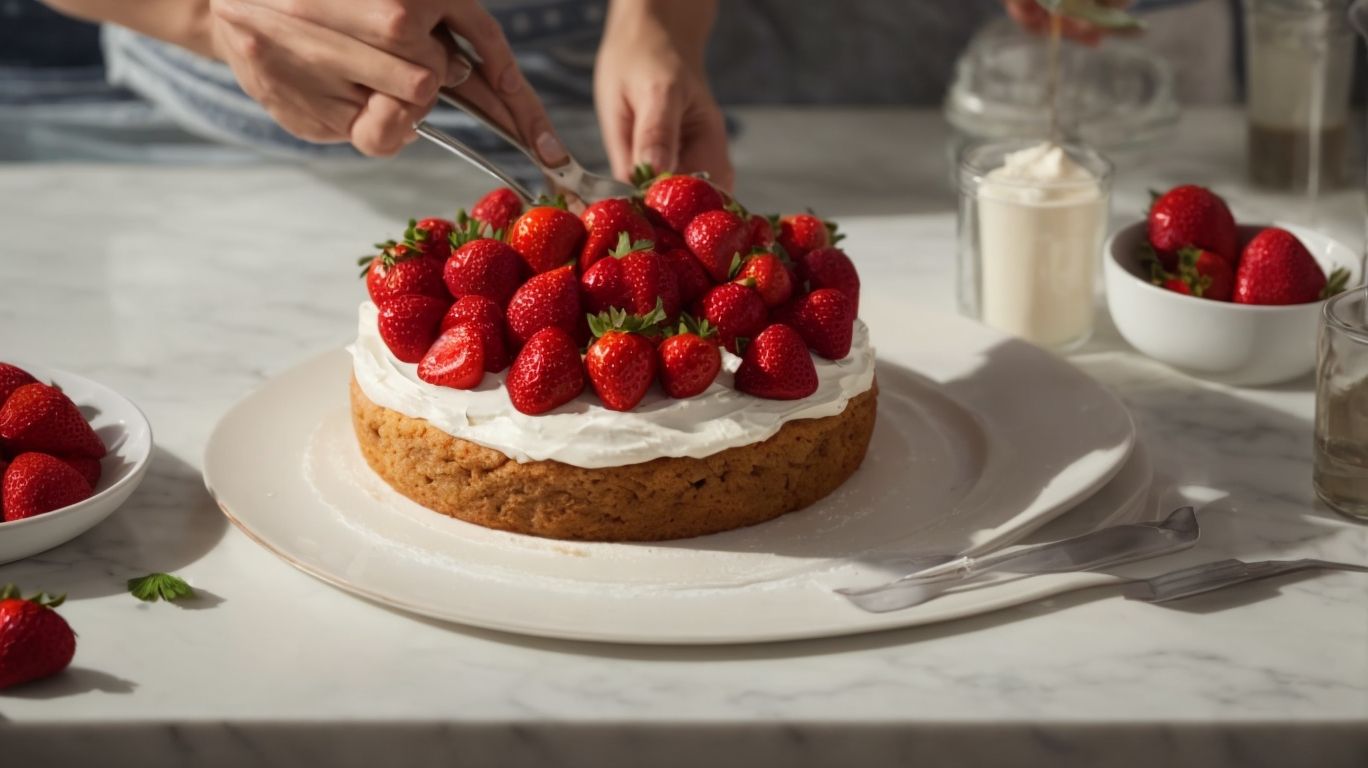How to Bake Strawberries Into a Cake?
Looking to elevate your baking game with the sweet and juicy flavor of strawberries?
We explore the reasons why strawberries are a fantastic addition to your baked goods. From the nutritional benefits of strawberries to tips on how to prevent them from sinking to the bottom of your cakes, we cover everything you need to know to master the art of baking with strawberries.
Grab your mixing bowls and let’s get started!
Key Takeaways:
Why Use Strawberries in Baking?
Enhancing your baked goods with strawberries not only adds a burst of fresh flavor but also introduces a delightful natural sweetness and vibrant color to your treats.
Strawberries are a versatile addition to a variety of baked goods, from traditional cakes and muffins to more innovative pastries and tarts. Their flavor-enhancing properties make them an excellent companion to other ingredients, such as chocolate, vanilla, and citrus, creating complex yet well-balanced flavor profiles that tantalize the taste buds.
The natural sweetness of strawberries helps reduce the need for excessive sugar in recipes, allowing for a healthier alternative without compromising on taste. The visual appeal they bring with their bright red hue can instantly elevate the presentation of your baked creations, making them visually appealing and appetizing.
What Are the Nutritional Benefits of Strawberries?
Strawberries are a nutrient-rich fruit packed with antioxidants, vitamins, and minerals that offer numerous health benefits when consumed regularly.
One of the standout features of strawberries is their high antioxidant content, particularly from a group of compounds known as polyphenols, such as ellagic acid and anthocyanins. These antioxidants are crucial in fighting free radicals in the body, which can help reduce inflammation and lower the risk of chronic diseases.
In addition, strawberries are an excellent source of Vitamin C, providing more than the recommended daily intake in just one serving. This vitamin is essential for a healthy immune system, skin health, and collagen production, making it a vital nutrient for overall well-being.
Furthermore, strawberries contain a variety of minerals, including potassium, manganese, and folate. Potassium helps regulate blood pressure, while manganese is important for bone health and metabolism. Folate, on the other hand, is crucial for prenatal care and cell division.
How Do Strawberries Enhance the Flavor of Baked Goods?
Strawberries infuse baked goods with a refreshing and fruity taste, adding a natural sweetness and tang that elevates the overall flavor profile of cakes, muffins, and tarts.
When incorporated into batters or fillings, strawberries release their juices, blending harmoniously with the other ingredients, creating a moist and flavorful texture. The burst of color and the hint of acidity from the strawberries brighten up the appearance and taste of the baked treats.
Strawberries are not just a garnish; they contribute essential moisture and depth of flavor, making them a versatile and sought-after fruit in the realm of baking.
What Type of Strawberries Should You Use for Baking?
Selecting the right strawberries for baking is crucial to ensuring optimal flavor and texture in your desserts.
When choosing strawberries, look for ones that are firm, plump, and brightly colored, indicating peak ripeness. The fresher the strawberries, the more vibrant and sweet they will be once baked into your treats. For recipes like strawberry shortcakes or pies, slightly riper berries can impart a juicier and more tender fruit filling. On the other hand, for baked goods like strawberry tarts or cakes, firmer strawberries hold their shape better during the baking process, offering a delightful contrast in texture. Ultimately, the quality of your strawberries can make or break the success of your baked creations.
Fresh vs Frozen Strawberries
When deciding between fresh and frozen strawberries for baking, consider the texture, juiciness, and convenience each option offers in your culinary creations.
Fresh strawberries, with their vibrant color and firm texture, can add a burst of freshness to your baked goods, enhancing both the visual appeal and the taste profile. On the other hand, frozen strawberries, although they may lack some of the visual appeal of fresh ones, often retain more moisture, adding a delicious juiciness to your desserts.
Fresh strawberries may require washing, hulling, and slicing before use, which can be time-consuming compared to the effortless usability of frozen strawberries straight from the freezer. On the contrary, the texture of fresh strawberries can sometimes soften during the baking process, whereas frozen strawberries tend to hold their shape and texture better.
Organic vs Conventionally Grown Strawberries
The choice between organic and conventionally grown strawberries for baking rests on considerations of pesticide exposure, environmental impact, and personal preferences regarding farming practices.
Regarding pesticide residues, organic strawberries are cultivated without synthetic chemicals, reducing the risk of exposure to harmful substances found in conventional farming. This distinction has led organic strawberries to be perceived as a healthier option for baking, aligning with the increasing consumer demand for cleaner food choices.
In terms of sustainability, organic farming practices prioritize soil health, biodiversity, and resource conservation. This focus on environmental stewardship distinguishes organic strawberries as a more eco-friendly choice compared to their conventionally grown counterparts, which often rely on synthetic fertilizers and pesticides.
Consumer choices play a significant role in the decision-making process, with individuals considering factors such as taste, price, and ethical considerations when selecting between organic and conventionally grown strawberries for baking. Understanding these distinctions can enable consumers to make informed decisions that align with their values and preferences.
How to Prepare Strawberries for Baking?

Credits: Poormet.Com – James Robinson
Properly preparing strawberries for baking involves washing, hulling, and slicing them to the desired size and consistency for optimal integration into your recipes.
Begin by choosing ripe strawberries that are firm and free of blemishes. To clean them, gently rinse the strawberries under cold running water to remove any dirt or debris. Removing the stems is the next step, as they can be tough and detract from the texture of your baked goods.
Once the stems are removed, it’s time to slice the strawberries. For uniform pieces, consider cutting them into halves or quarters, depending on your recipe’s requirements. Slicing techniques vary based on personal preference and the desired aesthetic of your dish.
Washing and Drying the Strawberries
Before using strawberries in your baking endeavors, it is vital to thoroughly wash and gently dry them to remove any impurities or residues that may affect the taste and quality of your final creations.
To begin, place the strawberries in a colander under cool running water.
Gently rub each berry with your fingers to remove any dirt or debris clinging to the surface. Ensure to handle the delicate fruit with care to avoid bruising or damaging the flesh.
After rinsing, transfer the strawberries to a clean kitchen towel or paper towels to gently pat them dry. Removing excess moisture is crucial to prevent soggy texture in your baked goods and to enhance the flavor concentration.
Slicing and Dicing Techniques
Mastering the art of slicing and dicing strawberries for baking involves precise cuts, uniform sizes, and consistent shapes to ensure even distribution and visual appeal in your culinary creations.
Regarding slicing strawberries, ensuring uniformity in size not only enhances the appearance of your dish but also promotes even cooking. To achieve this, start by selecting ripe strawberries that are firm and evenly colored. Rinse them gently under cold water and pat them dry. Next, using a sharp knife, carefully remove the green stems, then place the strawberry on a flat surface to create clean slices. For diced strawberries, make parallel cuts first, then rotate the strawberry and make perpendicular cuts.
What Types of Baked Goods Can You Make with Strawberries?
Strawberries offer a versatile ingredient that can be incorporated into various baked goods, including cakes, tarts, muffins, and cheesecakes, adding a delightful burst of flavor and color to each creation.
Regarding cakes, strawberries can be used in multiple ways – as a filling between layers, sliced on top for decoration, or even blended into the batter itself for a fruity twist. In tarts, the natural sweetness of strawberries pairs beautifully with a buttery crust, creating a harmonious balance of flavors. Muffins benefit from the juicy texture of strawberries, whether they’re chopped and folded into the batter or placed on top for a fresh finish.
Strawberry Cake
Crafting a delectable strawberry cake involves blending fresh strawberries into the batter and frosting, creating a moist and flavorful dessert that captures the essence of this luscious fruit.
To infuse the cake with the sweet and tangy essence of strawberries, start by pureeing ripe strawberries to create a rich and fragrant base for the batter. This puree not only adds moisture but also a burst of fresh flavor throughout every bite. For the frosting, incorporating fresh strawberry puree into a luscious buttercream creates a silky and pink-hued topping that complements the cake beautifully.
The trick lies in balancing the sweetness of the cake with the natural tartness of the strawberries, ensuring each component harmonizes to deliver a truly indulgent treat. Garnishing the cake with fresh strawberry slices adds a delightful finishing touch, making it a visually stunning and delectable dessert for any occasion.
Strawberry Tart
A strawberry tart combines the buttery crispness of pastry crust with a luscious strawberry filling, creating a delightful dessert that showcases the natural sweetness and vibrant color of fresh strawberries.
The process of crafting a strawberry tart begins with preparing the rich, flaky pastry crust that serves as the foundation for this delectable treat. The delicate balance of butter, flour, and sugar in the crust creates a texture that is both tender and slightly crisp, providing the perfect base for the juicy strawberry filling to come. As the tart bakes, the sweet aroma of strawberries fills the kitchen, heightening the anticipation of that first bite.
Strawberry Muffins
Whipping up a batch of strawberry muffins infuses your kitchen with the sweet aroma of fresh strawberries, offering a delightful treat that combines moist muffin texture with bursts of juicy strawberry flavor.
If you aim to enhance the moistness of your muffins, consider incorporating ingredients like Greek yogurt or buttermilk into the batter. These additions not only contribute to a soft and tender crumb but also intensify the fruity bursts of the strawberries when you take a bite.
To elevate the aromatic profile of your strawberry muffins, don’t hesitate to sprinkle a touch of cinnamon or nutmeg into the mix. These warm spices complement the sweet-tartness of the berries, creating a harmonious blend of flavors that will tantalize your taste buds.
Strawberry Cheesecake
Indulge in the creamy richness of a strawberry cheesecake, where velvety smooth cream cheese meets a tangy strawberry topping, creating a decadent dessert that balances sweet and tangy flavors perfectly.
Picture the luscious layers of velvety cream cheese, delicately whipped to perfection, cradled on a buttery graham cracker crust. As you take a bite, the flavors dance on your palate, with each mouthful offering a symphony of textures and tastes. The vibrant crimson hue of the ripe strawberries glistens invitingly, promising a burst of freshness with every forkful. The marriage of the creamy cheesecake and the zesty strawberry syrup forms a harmonious union, leaving a lingering, delightful aftertaste that keeps you craving more.
Tips for Incorporating Strawberries into Baked Goods

Credits: Poormet.Com – Douglas Flores
To elevate your baked goods with strawberries, consider techniques to enhance flavor, prevent sogginess, and ensure proper distribution of strawberries throughout your recipes for a delightful culinary experience.
When incorporating strawberries into your baked treats, choosing ripe berries is crucial. Ripe strawberries not only provide optimal sweetness but also hold their shape better during baking, enhancing both flavor and texture. Additionally, macerating the strawberries with a sprinkle of sugar can intensify their taste and create a luscious syrup, perfect for moistening cakes and pastries.
To avoid sogginess, lightly coating the strawberries in flour or cornstarch before adding them to the batter can help absorb excess moisture. Strategically placing the strawberries evenly throughout the batter ensures each bite is bursting with fruity goodness.
How to Avoid Soggy Baked Goods?
Preventing sogginess in baked goods when using strawberries involves techniques such as patting dry the fruit, adjusting flour content, and incorporating absorbent ingredients to maintain the desired texture and integrity of your treats.
When preparing strawberry-infused baked treats, effective moisture management plays a crucial role in keeping them enjoyable. To start, after washing and slicing your strawberries, pat them dry using paper towels to remove excess moisture. This simple step helps prevent the fruit from releasing too much liquid during baking, which can lead to a soggy final product.
Consider making slight adjustments to your flour content by slightly reducing it, compensating for the additional moisture introduced by the strawberries. To further combat sogginess, opt for absorbent ingredients such as oats, nuts, or coconut to help soak up excess liquid and preserve the texture and flavor of your creations.
How to Enhance the Strawberry Flavor?
Amplifying the natural strawberry flavor in your baked goods can be achieved by incorporating concentrated strawberry puree, freeze-dried strawberries, or natural extracts to intensify the fruity essence in your recipes.
When using concentrated strawberry puree, ensure you reduce the liquid content in your recipe to maintain the desired consistency. This puree packs a punch of intense strawberry flavor without adding extra moisture. On the other hand,
- freeze-dried strawberries can be ground into a fine powder and mixed directly into the batter or frosting to infuse a concentrated burst of strawberry essence throughout the baked item.
- Natural extracts like strawberry extract are potent and can be used sparingly to add a subtle yet distinct strawberry taste, enhancing both the flavor and aroma of your creations.
Experimenting with these flavor-enhancing elements can take your strawberry baked goods to a whole new level of deliciousness.”
How to Prevent the Strawberries from Sinking to the Bottom?
To prevent strawberries from sinking to the bottom of your baked goods, consider coating them in flour, adjusting batter consistency, or strategically layering the fruit within the mixture to ensure even distribution and integration.
Coating strawberries in a thin layer of cornstarch instead of flour can also be effective in preventing them from sinking.
When adjusting batter consistency, aim for a slightly thicker batter to provide better support for the strawberries. Experiment with folding the strawberries into the batter gently to minimize disruption to their structure. Try layering the strawberries in a patterned arrangement to create a more aesthetically pleasing result while maintaining fruit distribution. By utilizing these techniques, you can elevate your baked goods with perfectly suspended strawberries throughout.
Frequently Asked Questions
How to Bake Strawberries Into a Cake?
What ingredients do I need to bake a strawberry cake?
Can I use frozen strawberries instead of fresh ones?
How should I prepare the strawberries before baking them into the cake?
How do I prevent the strawberries from sinking to the bottom of the cake?
Can I substitute the strawberries with a different type of fruit?
How to Bake Strawberries Into a Cake?
To bake strawberries into a cake, you will need to follow a specific recipe and have the necessary ingredients and equipment.
What ingredients do I need to bake a strawberry cake?
You will need all-purpose flour, baking powder, salt, butter, granulated sugar, eggs, vanilla extract, milk, and of course, fresh strawberries.
Can I use frozen strawberries instead of fresh ones?
Yes, you can use frozen strawberries in this recipe. Just make sure to thaw them first and pat them dry before using.
How should I prepare the strawberries before baking them into the cake?
Wash the strawberries and remove the stems. Slice them thinly and toss them in a bit of sugar to bring out their natural juices.
How do I prevent the strawberries from sinking to the bottom of the cake?
To prevent the strawberries from sinking, toss them in a bit of flour before adding them to the cake batter. This will help them stay suspended in the batter while baking.
Can I substitute the strawberries with a different type of fruit?
Yes, you can use other types of fruit such as blueberries, raspberries, or even peaches in this recipe. Just make sure to adjust the amount of sugar used based on the sweetness of the fruit.

